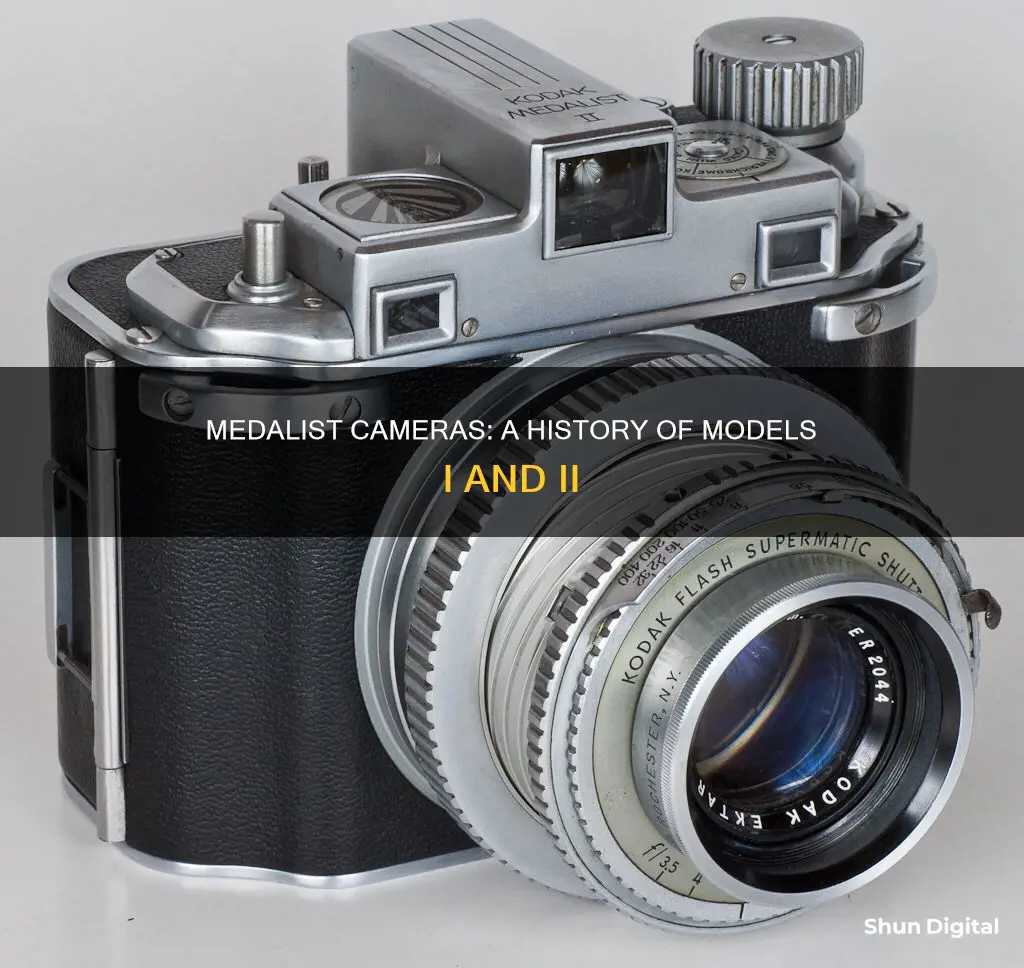
The Kodak Medalist I and II are medium-format rangefinder cameras that were built by the Eastman Kodak Company between 1941 and 1953. The original Medalist I was introduced in 1941 and was used by the US Navy during World War II. The Medalist II was released in 1946-1947 as an improved version aimed at the home market.
| Characteristics | Values |
|---|---|
| Manufacturer | Eastman Kodak Company |
| Years of Production | 1941 to about 1952/1953 |
| Models | Medalist I, Medalist II |
| Production Years | Medalist I: 1941; Medalist II: 1946/1947 |
| Film | 620 Roll Film |
| Exposures | 8 6x9 exposures |
| Weight | 3 pounds/46.710 oz/1,324.3g |
| Use | Used by US and British armed forces during World War II |
What You'll Learn

The Kodak Medalist I was first introduced in 1941
The Kodak Medalist I featured a coupled rangefinder, a superb lens, and unique design elements such as the exposed focusing helicoid. It was equipped with a Kodak Supermatic shutter and lenses that were coated on the interior surfaces. One notable feature was the micro-focusing knob located below the lens, which allowed for fine-tuning of the focus. The camera also had a shutter button lock, which could be used for long exposures but required careful operation to avoid damaging the shutter-cocking mechanism.
The Medalist I had a distinctive appearance with its die-cast construction, exposed helical on the lens barrel, and centred viewfinder and rangefinder windows. Despite its bulk, it represented a pinnacle of American camera design and manufacturing at the time. The camera was known for its durability, with some users reporting its continued use decades after its release.
The Medalist I was succeeded by the Medalist II, which was released in 1946 or 1947. The Medalist II added flash sync but removed certain features such as the self-timer and fine-focus knob to accommodate the new flash socket and synchronizing mechanism. The lens coatings on the Medalist II were improved, with all interior and exterior surfaces coated. Other differences between the models included cosmetic changes and modifications to the shutter and film transport mechanisms.
Loading Camera Raw Presets: XMP Files Explained
You may want to see also

The Kodak Medalist II was released in 1947
The Kodak Medalist is a medium-format rangefinder camera that was first introduced in 1941. The camera was produced in two versions: the original Medalist, also known as the Medalist I, and the Medalist II, which was released in 1947.
The Kodak Medalist II was an improved version of the original Medalist, aimed at the home market. It added flash sync but removed the self-timer and fine-focus knob due to the space occupied by the new flash socket and synchronizing mechanism. The camera featured a collapsible lens design, a dual-hinged removable film back, and a super-sharp 100mm f/3.5 Ektar lens. It captured eight 6 x 9 cm exposures on each roll of 620 film, though many photographers adapted it to take 120 film.
The Kodak Medalist II was designed by Walter Dorwin Teague and Joe Mihalyi and built by the Eastman Kodak Company. It was made in the United States and sold for $312.50 with an "ever-ready" case in 1947, which is equivalent to about $3500 in today's money. The camera was well-regarded upon its release and is considered by some to be one of the best American-made cameras of its time.
The Kodak Medalist II had a significant impact on photography and is still sought after by collectors today. Its combination of features, technology, and its excellent lens made it a standout in the history of American-made cameras. Despite its bulky size and weight, the Medalist II produced superb image quality and offered a unique shooting experience that is still appreciated by photographers and collectors.
Rechargeable Camera Batteries: Charged or Not When Bought?
You may want to see also

The Kodak Medalist I was used by the US Navy in WWII
The Kodak Medalist I was used by the US Navy in World War II. The camera was introduced in 1941 and was immediately chosen by the US Navy for service in the war. The Kodak Medalist was an unusual design for a medium-format camera when it was introduced. Most roll-film cameras of this vintage were folders, but the Medalist had a rigid cast-aluminum body design with a unique double helical lens tube. This design was stronger, protected internal mechanisms better, and was nearly as compact when the lens was retracted. The camera was produced in two versions: the original Medalist, and the Medalist II which came out in 1946.
The Medalist I was a high-quality but bulky and heavy medium format rangefinder camera that made 8 6x9 exposures on 620 film. It was made in the US by Kodak from 1941. The camera was designed by Walter Dorwin Teague, a famous American industrial designer. The Medalist I had a coupled rangefinder, a superb lens, and some unique design features, most notably the exposed focusing helicoid. The lens on the Medalist I was a 5-element coated f/3.5 Ektar of a Heliar design by F. E. Altman that is sharp, even by today's standards. The Ektar for the Medalist I had inner air-glass surfaces coated. The camera was used extensively during World War II by the American services. Its rugged and durable tank-like build made it an attractive option for the US and British armed forces.
The Medalist I was produced from 1941 to 1948, while the Medalist II was produced from 1946 to 1953. The first model was reportedly used by multiple branches of the US Armed Forces during World War II, when the great camera makers in Germany and Japan were fighting on the opposite side. In many ways, this was an ideal camera for military use. It was solid cast metal with a fairly rugged mechanism and produced extremely sharp images with large negatives. It was also said to be easy to repair with simple tools, given the right parts. The Medalist I had a micro-focusing knob on the front below the lens, which was not carried over to the Medalist II. The Medalist II had a large flash connector in the place where the micro-focusing knob used to be.
HDR Mode: Moto G Camera's Dynamic Range Boost
You may want to see also

The Kodak Medalist II added flash sync but removed the self-timer
The Kodak Medalist II is a post-World War II version of the original Kodak Medalist camera, also known as the Medalist I. The Kodak Medalist II added flash sync but removed the self-timer and fine-focus knob. The self-timer and fine-focus knob were removed due to the space occupied by the new flash socket and synchronizing mechanism. The flash sync feature allowed photographers to use flash photography, which was not possible with the original Medalist camera.
The Kodak Medalist II was released in 1947, two years after World War II ended. It was aimed at the home market, in contrast to the Medalist I, which was used extensively by the US and British armed forces during World War II. The Medalist II offered several improvements over its predecessor, including a fully coated ("Lumenized") lens, automatic F and M flash sync, and an improved film transport mechanism.
The Kodak Medalist II is a medium-format rangefinder camera that captures eight 6 x 9 cm exposures on each roll of 620 film. It features a super-sharp 100mm f/3.5 lens and a collapsible lens design, with the lens retracting into the body when not in use. The camera is known for its rugged and durable build, with a solid cast metal construction. It also features a dual-hinged removable film back, separate viewfinder and rangefinder windows, and a unique exposed focusing helicoid.
While the Kodak Medalist II offered several advancements, it also had some limitations. In addition to the removal of the self-timer and fine-focus knob, it lacked a traditional PC flash sync connector and a fine-focus knob. The camera was also quite bulky and heavy, weighing slightly over 3 pounds. Despite these drawbacks, the Kodak Medalist II was a highly regarded camera and continued to hold its own against modern gear even after its discontinuation in 1953.
Troubleshooting a Wyze Camera That Won't Charge
You may want to see also

The Kodak Medalist I and II are large and heavy cameras
The Kodak Medalist I and II are bulky and heavy medium format rangefinder cameras that make 8 6x9 exposures on 620 film. The cameras were made in the USA by Kodak, with the Medalist I being introduced in 1941 and the Medalist II following in 1946 or 1947. The Medalist I weighed slightly more than 3 pounds, and its rugged and durable build made it attractive to the US and British armed forces during World War II. The Medalist II was aimed at the home market and was discontinued in 1953, but both cameras still hold up against modern gear.
The Kodak Medalist I and II are large and impressive cameras that represent a pinnacle of American camera design and manufacturing. The cameras are unique and pretty, with the exposed helical on the lens barrel, the centered viewfinder and rangefinder windows, and the deep body creating a work of functional art. The 100/3.5 Ektar lens is capable of producing very high-quality and unique images, and the build quality ensures decades of use.
How to Find the Mode Button on the S7 Camera
You may want to see also
Frequently asked questions
The Kodak Medalist I was first introduced in 1941.
The Kodak Medalist II was released in 1947.
The Medalist I was designed for the American military and very few were sold commercially. The Medalist II was aimed at the home market and added flash sync, but removed the self-timer and fine-focus knob. The Medalist II also had a redesigned logo and depth of field dial, and an improved film transport mechanism.
Both cameras are medium-format rangefinders that capture eight 6 x 9 cm exposures using 620 film. They feature a sharp 100mm f/3.5 Ektar lens with 5 elements in 3 groups, and a collapsible design with an exposed helical. The lens retracts into the body when not in use, and the camera can be mounted on a tripod.







